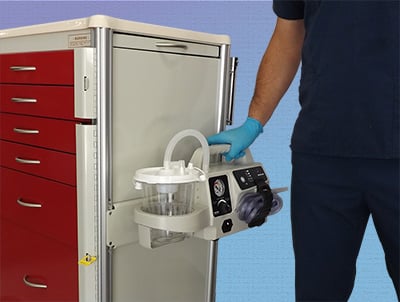
Suction plays a critical role in numerous medical procedures. It’s also a key component of every tactical medical kit. Yet many first responders and other medical professionals are familiar with only one or two suction aspirators. In an emergency or when you collaborate with another agency, your familiarity with a wide range of suction equipment may be the most important factor in patient outcomes. Here are the types of suction aspirators you might encounter.
The Different Suction Options
The type of suctioning equipment you use often depends on the type of suctioning you intend to do. There are four basic types:
- Oropharyngeal suctioning: The most commonly used form of suctioning in emergency medicine, this type maintains a patent airway by suctioning the throat via the mouth.
- Nasopharyngeal suctioning: An alternative to oropharyngeal suctioning, nasopharyngeal suctioning allows access to the throat through the nose. It can be especially helpful for patients with broken or missing teeth, serious jaw injuries, or any type of physical trauma that makes accessing the mouth difficult.
- Nasotracheal suctioning: Nasotracheal suctioning, like nasopharyngeal suctioning, accesses the airway through the nose but is reserved for middle and lower airway issues.
- Suctioning through an artificial airway: Artificial airways must regularly be cleared of secretions. Patients with airway obstructions may also require suctioning through an artificial airway.
Manual Suction Units
Manual airway aspirators are often used in emergency settings and low-tech medicine. For example, a first responder in a developing nation or war zone might use manual suction. These units are hand-powered, and while it is difficult to sustain consistent suction, but can work well in an emergency.
Makeshift Suction Devices
Virtually any tube-shaped device—such as a straw or a thin pipette—can be used as a makeshift suction device in an emergency. These devices are less reliable and offer less effective and consistent suction. They are also more likely to cause airway trauma, especially when used by an unskilled person.
Your agency may want to offer training on makeshift suction to consumers, who may need to use a straw or other device to clear a loved one’s airway in an emergency. However, there is no reason to use a makeshift suction device.
Wall-Mounted Suction
Traditional wall-mounted suction is the steady, reliable workhorse of the suction world. It gets the job done. The problem is it’s not portable. Even in a hospital that has a wall-mounted unit in every room, patients may need more. Wall-mounted suction can't benefit an aspirating patient in the emergency room or a baby delivered in the parking lot who has a respiratory obstruction. Under the Emergency Medical Treatment and Labor Act, hospitals must provide stabilizing emergency care to patients within a 250-yard radius of the campus. Wall-mounted suction units are inadequate.
Emergency Portable Suction
Portable emergency suction devices allow doctors, first responders, and other healthcare workers to go directly to the patient, without the risks and delays inherent in moving the patient. They offer suction similar to that of a wall-mounted unit, but without tying a first responder to the ambulance.
The right portable emergency suction device has a long battery life, is compatible with a variety of attachments, and delivers consistent, reliable suction. For help choosing the right machine for your agency, download our free guide, The Ultimate Guide to Purchasing a Portable Emergency Suction Device.
Editor's Note: This blog was originally published in June 2017. It has been re-published with additional up to date content.
















